The Estimation of Grassland Aboveground Biomass and Analysis of Its Response to Climatic Factors Using a Random Forest Algorithm in Xinjiang, China
Abstract
:1. Introduction
2. Results
2.1. Model Establishment and Accuracy Evaluation
2.2. Spatial and Temporal Dynamic Distribution of Grassland AGB in Xinjiang
2.2.1. Descriptive Statistics of Measured Grassland AGB
2.2.2. Temporal Changes in Grassland AGB in Xinjiang from 2000 to 2022
2.2.3. Spatial Distribution of Grassland AGB in Xinjiang from 2000 to 2022
2.3. Influence of Climatic Factors on Grassland AGB Dynamics
2.3.1. Spatial and Temporal Distribution of Climatic Conditions in Grassland AGB
2.3.2. Correlation between Climatic Factors and Grassland AGB
3. Discussion
3.1. Comparison of AGB Estimates for Different Grasslands
3.2. The Main Reasons for the Improvement in AGB in Xinjiang Grassland
3.3. Limitations and Future Prospects
4. Materials and Methods
4.1. Study Area
4.2. Data Sources
4.2.1. Sample Data
4.2.2. Remote Sensing and Climate Dataset
4.3. Methods
4.3.1. The AGB Model Based on Random Forest Algorithm
4.3.2. Model Validation
4.3.3. Trend Analysis
4.3.4. Correlation Analysis
4.3.5. Mann–Kendall Mutation Test
5. Conclusions
Author Contributions
Funding
Data Availability Statement
Acknowledgments
Conflicts of Interest
References
- Schindler, D.W. The mysterious missing sink. Nature 1999, 398, 105–107. [Google Scholar] [CrossRef]
- Scurlock, J.M.O.; Johnson, K.; Olson, R.J. Estimating net primary productivity from grassland biomass dynamics measurements. Glob. Change Biol. 2002, 8, 736–753. [Google Scholar] [CrossRef]
- Zhang, J.; Fang, S.B.; Liu, H.H. Estimation of alpine grassland above-ground biomass and its response to climate on the Qinghai-Tibet Plateau during 2001 to 2019. Glob. Ecol. Conserv. 2022, 35, e02065. [Google Scholar] [CrossRef]
- Wang, Y.; Qin, R.Q.; Cheng, H.Z.; Liang, T.G.; Zhang, K.P.; Chai, N.; Gao, J.L.; Feng, Q.S.; Hou, M.J.; Liu, J.; et al. Can Machine Learning Algorithms Successfully Predict Grassland Aboveground Biomass? Remote Sens. 2022, 14, 3843. [Google Scholar] [CrossRef]
- Luo, R.; Yang, S.; Zhou, Y.; Gao, P.; Zhang, T. Spatial pattern analysis of a water-related ecosystem service and evaluation of the grassland-carrying capacity of the Heihe river basin under land use change. Water 2021, 13, 2658. [Google Scholar] [CrossRef]
- Zhang, S.; Wang, Y.; Xu, W.; Sheng, Z.; Zhu, Z.; Hou, Y. Analysis of Spatial and Temporal Variability of Ecosystem Service Values and Their Spatial Correlation in Xinjiang, China. Remote Sens. 2023, 15, 4861. [Google Scholar] [CrossRef]
- Dong, X.B.; Yang, W.K.; Ulgiati, S.; Yan, M.C.; Zhang, X.S. The impact of human activities on natural capital and ecosystem services of natural pastures in North Xinjiang, China. Ecol. Model. 2012, 225, 28–39. [Google Scholar] [CrossRef]
- Guan, K.; Wu, J.; Kimball, J.S.; Anderson, M.C.; Frolking, S.; Li, B.; Hain, C.R.; Lobell, D.B. The shared and unique values ofoptical, fluorescence, thermal and microwave satellite data for estimating large-scale crop yields. Remote Sens. Environ. 2017, 199, 333–349. [Google Scholar] [CrossRef]
- John, R.; Chen, J.; Giannico, V.; Park, H.; Xiao, J.F.; Shirkey, G.; Ouyang, Z.; Shao, C.L.; Lafortezza, R.; Qi, J.G. Grassland canopy cover and aboveground biomass in Mongolia and Inner Mongolia: Spatiotemporal estimates and controlling factors. Remote Sens. Environ. 2018, 213, 34–48. [Google Scholar] [CrossRef]
- Wang, G.; Jing, C.; Dong, P.; Qin, B.; Cheng, Y. Spatiotemporal dynamics of aboveground biomass and its influencing factors in Xinjiang’s desert grasslands. Sustainability 2022, 14, 14884. [Google Scholar] [CrossRef]
- Han, W.; Guan, J.; Zheng, J.; Liu, Y.; Ju, X.; Liu, L.; Li, J.; Mao, X.; Li, C. Probabilistic assessment of drought stress vulnerability in grasslands of Xinjiang, China. Front. Plant Sci. 2023, 14, 1143863. [Google Scholar] [CrossRef] [PubMed]
- Wang, D.O.; Xin, X.P.; Shao, Q.Q.; Brolly, M.; Zhu, Z.L.; Chen, J. Modeling aboveground biomass in Hulunber grassland ecosystem by using unmanned aerial vehicle discrete lidar. Sensors 2017, 17, 180. [Google Scholar] [CrossRef] [PubMed]
- Zhang, H.F.; Sun, Y.; Chang, L.; Qin, Y.; Chen, J.J.; Qin, Y.; Du, J.X.; Yi, S.H.; Wang, Y.L. Estimation of grassland canopy height and aboveground biomass at the quadrat scale using unmanned aerial vehicle. Remote Sens. 2018, 10, 851. [Google Scholar] [CrossRef]
- Ramoelo, A.; Cho, M.A.; Mathieu, R.; Madonsela, S.; Van De Kerchove, R.; Kaszta, Z.; Wolff, E. Monitoring grass nutrients and biomass as indicators of rangeland quality and quantity using random forest modelling and WorldView-2 data. Int. J. Appl. Earth Obs. Geoinf. 2015, 43, 43–54. [Google Scholar] [CrossRef]
- Mundava, C.; Helmholz, P.; Schut, A.G.; Corner, R.; McAtee, B.; Lamb, D.W. Evaluation of vegetation indices for rangeland biomass estimation in the Kimberley area of Western Australia. ISPRS Ann. Photogramm. Remote. Sens. Spat. Inf. Sci. 2014, 2, 47–53. [Google Scholar] [CrossRef]
- Guo, R.; Gao, J.; Fu, S.; Xiu, Y.; Zhang, S.; Huang, X.; Feng, Q.; Liang, T. Estimating aboveground biomass of alpine grassland during the wilting period using in situ hyperspectral, Sentinel-2 and Sentinel-1 data. IEEE Trans. Geosci. Remote Sens. 2023. [Google Scholar] [CrossRef]
- Zhou, J.; Zhang, R.; Guo, J.; Dai, J.; Zhang, J.; Zhang, L.; Miao, Y. Estimation of aboveground biomass of senescence grassland in China’s arid region using multi-source data. Sci. Total Environ. 2024, 170602. [Google Scholar] [CrossRef]
- Paruelo, J.M.; Epstein, H.E.; Lauenroth, W.K.; Burke, I.C. ANPP estimates from NDVI for the central grassland region of the US. Ecology 1997, 78, 953–958. [Google Scholar] [CrossRef]
- Ma, A.N.; Yu, G.R.; He, N.P.; Wang, Q.F.; Peng, S.L. Above-and below-ground biomass relationships in China’s grassland vegetation. Quat. Sci. 2014, 34, 769–776. [Google Scholar] [CrossRef]
- Wang, G.X.; Jing, C.Q.; Dong, P.; Qin, B.Y. Distribution patterns of aboveground and belowground biomass in desert grassland in Xinjiang. Pratacult. Sci. 2023, 40, 1201–1209. [Google Scholar] [CrossRef]
- Ding, L.; Li, Z.W.; Shen, B.B.; Wang, X.; Xu, D.W.; Yan, R.R.; Yan, Y.C.; Xin, X.P.; Xiao, J.F.; Li, M.; et al. Spatial patterns and driving factors of aboveground and belowground biomass over the eastern Eurasian steppe. Sci. Total Environ. 2022, 803, 149700. [Google Scholar] [CrossRef]
- Shao, Q.Q.; Liu, J.Y.; Huang, L.; Fan, J.W.; Xu, X.L.; Wang, J.B. Integrated assessment on the effectiveness of ecological conservation in Sanjiangyuan National Nature Reserve. Geogr. Res. 2013, 32, 1645–1656. [Google Scholar] [CrossRef]
- Myneni, R.B.; Keeling, C.D.; Tucker, C.J.; Asrar, G.; Nemani, R.R. Increased plant growth in the northern high latitudes from 1981 to 1991. Nature 1997, 386, 698–702. [Google Scholar] [CrossRef]
- Zeng, N.; Ren, X.L.; He, H.L.; Zhang, L.; Zhao, D.; Ge, R.; Li, P.; Niu, Z.G. Estimating grassland aboveground biomass on the Tibetan Plateau using a random forest algorithm. Ecol. Indic. 2019, 102, 479–487. [Google Scholar] [CrossRef]
- Gao, X.X.; Dong, S.K.; Li, S.; Xu, Y.D.; Liu, S.L.; Zhao, H.D.; Yeomans, J.; Li, Y.; Shen, H.; Wu, S.N.; et al. Using the random forest model and validated MODIS with the field spectrometer measurement promote the accuracy of estimating aboveground biomass and coverage of alpine grasslands on the Qinghai-Tibetan Plateau. Ecol. Indic. 2020, 112, 106114. [Google Scholar] [CrossRef]
- Yu, H.; Wu, Y.; Niu, L.; Chai, Y.; Feng, Q.; Wang, W.; Liang, T. A method to avoid spatial overfitting in estimation of grassland above-ground biomass on the Tibetan Plateau. Ecol. Indic. 2021, 125, 107450. [Google Scholar] [CrossRef]
- Wang, Y.; Wu, G.; Deng, L.; Tang, Z.; Wang, K.; Sun, W.; Shangguan, Z. Prediction of aboveground grassland biomass on the Loess Plateau, China, using a random forest algorithm. Sci. Rep. 2017, 7, 6940. [Google Scholar] [CrossRef] [PubMed]
- Ge, J.; Hou, M.; Liang, T.; Feng, Q.; Meng, X.; Liu, J.; Bao, X.; Gao, H. Spatiotemporal dynamics of grassland aboveground biomass and its driving factors in North China over the past 20 years. Sci. Total Environ. 2022, 826, 154226. [Google Scholar] [CrossRef]
- Fauvel, M.; Lopes, M.; Dubo, T.; Rivers-Moore, J.; Frison, P.L.; Gross, N.; Ouin, A. Prediction of plant diversity in grasslands using Sentinel-1 and-2 satellite image time series. Remote Sens. Environ. 2020, 237, 111536. [Google Scholar] [CrossRef]
- Zhou, W.; Li, H.; Xie, L.J.; Nie, X.M.; Wang, Z.; Du, Z.P.; Yue, T.X. Remote sensing inversion of grassland aboveground biomass based on high accuracy surface modeling. Ecol. Indic. 2021, 121, 107215. [Google Scholar] [CrossRef]
- Han, Q.F.; Li, Y.Y.; Peng, K.B.; Li, C.F.; Huang, X.D.; Xu, W.Q. Effects of atmospheric nitrogen deposition on net primary productivity of grassland ecosystem in central Asia. Acta Ecol. Sin. 2021, 41, 8545–8555. [Google Scholar] [CrossRef]
- Zhang, R.P.; Guo, J.; Zhang, Y.L. Spatial distribution pattern of grassland net primary productivity and its response to climate change in Xinjiang. Acta Ecol. Sin. 2020, 40, 5318–5326. [Google Scholar]
- Piao, S.; Fang, J.; He, J.; Xiao, Y. Patial distribution of grassland biomass in China. Chin. J. Plant Ecol. 2004, 28, 491–498. [Google Scholar] [CrossRef]
- Ma, W.; Fang, J.; Yang, Y.; Mai, A. Grassland biomass dynamics and its relationship with climatic factors in northern China. Sci. Sin. Vitae 2010, 40, 632–641. [Google Scholar] [CrossRef]
- Zhang, X.; Zhu, H.; Zhong, H.; Chen, Y.; Jin, G.; Shao, X. Assessment of above-ground Biomass of Grassland using remote sensing, Yili, Xinjiang. Acta Pratacult. Sin. 2015, 24, 25–34. [Google Scholar] [CrossRef]
- Fei, C.; Dong, Y.Q.; An, S.Z. Factors driving the biomass and species richness of desert plants in northern Xinjiang China. PLoS ONE 2022, 17, e0271575. [Google Scholar] [CrossRef] [PubMed]
- Xun, Q.L.; Dong, Y.Q.; An, S.Z.; Yan, K. Monitoring of grassland herbage accumulation by remote sensing using MOD09GA data in Xinjiang. Acta Pratacult. Sin. 2018, 27, 10–26. [Google Scholar] [CrossRef]
- Chen, C.B.; Li, G.Y.; Peng, J. Spatiotemporal analysis of net primary productivity for natural grassland in Xinjiang in the past 20 years. Arid Land Geogr. 2022, 45, 522–534. [Google Scholar]
- Zhang, R.; Liang, T.; Guo, J.; Xie, H.; Feng, Q.; Aimaiti, Y. Grassland dynamics in response to climate change and human activities in Xinjiang from 2000 to 2014. Sci. Rep. 2018, 8, 2888. [Google Scholar] [CrossRef] [PubMed]
- Wu, X.; Zhang, C.; Dong, S.; Hu, J.; Tong, X.; Zheng, X. Spatiotemporal changes of the aridity index in Xinjiang over the past 60 years. Environ. Earth Sci. 2023, 82, 392. [Google Scholar] [CrossRef]
- Wang, G.; Yuan, X.; Jing, C.; Hamdi, R.; Ochege, F.U.; Dong, P.; Shao, Y.; Qin, X. The decreased cloud cover dominated the rapid spring temperature rise in arid Central Asia over the period 1980–2014. Geophys. Res. Lett. 2024, 51, e2023GL107523. [Google Scholar] [CrossRef]
- Li, C.; Wang, R.; Ning, H.; Luo, Q. Characteristics of meteorological drought pattern and risk analysis for maize production in Xinjiang, Northwest China. Theor. Appl. Climatol. 2018, 133, 1269–1278. [Google Scholar] [CrossRef]
- Yao, J.; Chen, Y.; Zhao, Y.; Mao, W.; Xu, X.; Liu, Y.; Yang, Q. Response of vegetation NDVI to climatic extremes in the arid region of Central Asia: A case study in Xinjiang, China. Theor. Appl. Climatol. 2018, 131, 1503–1515. [Google Scholar] [CrossRef]
- Zhang, H.; Fan, J.; Shao, Q.; Zhang, Y. Ecosystem dynamics in the ‘Returning Rangeland to Grassland’ programs, China. Acta Pratacult. Sin. 2016, 25, 1–15. [Google Scholar] [CrossRef]
- Hu, Z.; Kong, D.; Wei, T.; Jin, L. Grassland eco-compensation equivalent relationship between livestock reduction and compensation. J. Nat. Resour. 2015, 30, 1846–1859. [Google Scholar] [CrossRef]
- Liu, Y.; Wang, Q.; Zhang, Z.; Tong, L.; Wang, Z.; Li, J. Grassland dynamics in responses to climate variation and human activities in China from 2000 to 2013. Sci. Total Environ. 2019, 690, 27–39. [Google Scholar] [CrossRef] [PubMed]
- Naeem, S.; Zhang, Y.; Tian, J.; Qamer, F.M.; Latif, A.; Paul, P.K. Quantifying the impacts of anthropogenic activities and climate variations on vegetation productivity changes in China from 1985 to 2015. Remote Sens. 2020, 12, 1113. [Google Scholar] [CrossRef]
- Wang, A.; Ma, J.; Gong, H.; Fan, G.; Wang, M.; Zhao, H.; Cheng, J. Patterns and drivers of species richness of early spring annual ephemeral plants in northern Xinjiang. Biodivers. Sci. 2021, 29, 735–745. [Google Scholar] [CrossRef]
- Garcia-Gutierrez, J.; Martínez-Álvarez, F.; Troncoso, A.; Riquelme, J.C. A comparative study of machine learning regression methods on LiDAR data: A case study. In Proceedings of the International Joint Conference SOCO’13-CISIS’13-ICEUTE’13, Salamanca, Spain, 11–13 September 2013; Springer International Publishing: Cham, Switzerland, 2014; pp. 249–258. [Google Scholar] [CrossRef]
- Meng, B.; Liang, T.; Yi, S.; Yin, J.; Cui, X.; Ge, J.; Hou, M.; Lv, Y.; Sun, Y. Modeling alpine grassland above ground biomass based on remote sensing data and machine learning algorithm: A case study in east of the Tibetan Plateau, China. IEEE J. Sel. Top. Appl. Earth Obs. Remote Sens. 2020, 13, 2986–2995. [Google Scholar] [CrossRef]
- Bishop, C.M.; Nasrabadi, N.M. Pattern Recognition and Machine Learning; Springer: New York, NY, USA, 2006; Volume 4, p. 738. [Google Scholar]
- Yang, S.; Feng, Q.; Liang, T.; Liu, B.; Zhang, W.; Xie, H. Modeling grassland above-ground biomass based on artificial neural network and remote sensing in the Three-River Headwaters Region. Remote Sens. Environ. 2018, 204, 448–455. [Google Scholar] [CrossRef]
- Liang, T.; Yang, S.; Feng, Q.; Liu, B.; Zhang, R.; Huang, X.; Xie, H. Multi-factor modeling of above-ground biomass in alpine grassland: A case study in the Three-River Headwaters Region, China. Remote Sens. Environ. 2016, 186, 164–172. [Google Scholar] [CrossRef]
- Friend, A.D.; Arneth, A.; Kiang, N.Y.; Lomas, M.; Ogee, J.; Rödenbeck, C.; Running, S.W.; Santaren, J.; Sitch, S.; Viovy, N.; et al. FLUXNET and modelling the global carbon cycle. Glob. Change Biol. 2007, 13, 610–633. [Google Scholar] [CrossRef]
- Breiman, L. Random Forests. Mach. Learn. 2001, 45, 5–32. [Google Scholar] [CrossRef]
- Cutler, D.R.; Edwards, T.C., Jr.; Beard, K.H.; Cutler, A.; Hess, K.T.; Gibson, J.; Lawler, J.J. Random forests for classification in ecology. Ecology 2007, 88, 2783–2792. [Google Scholar] [CrossRef]
- Che, D.; Liu, Q.; Rasheed, K.; Tao, X. Decision tree and ensemble learning algorithms with their applications in bioinformatics. In Software Tools and Algorithms for Biological Systems; Springer: New York, NY, USA, 2011; pp. 191–199. [Google Scholar] [CrossRef]
- Jabbar, H.; Khan, R.Z. Methods to avoid over-fitting and under-fitting in supervised machine learning (comparative study). Comput. Sci. Commun. Instrum. Devices 2015, 70, 978–981. [Google Scholar] [CrossRef]
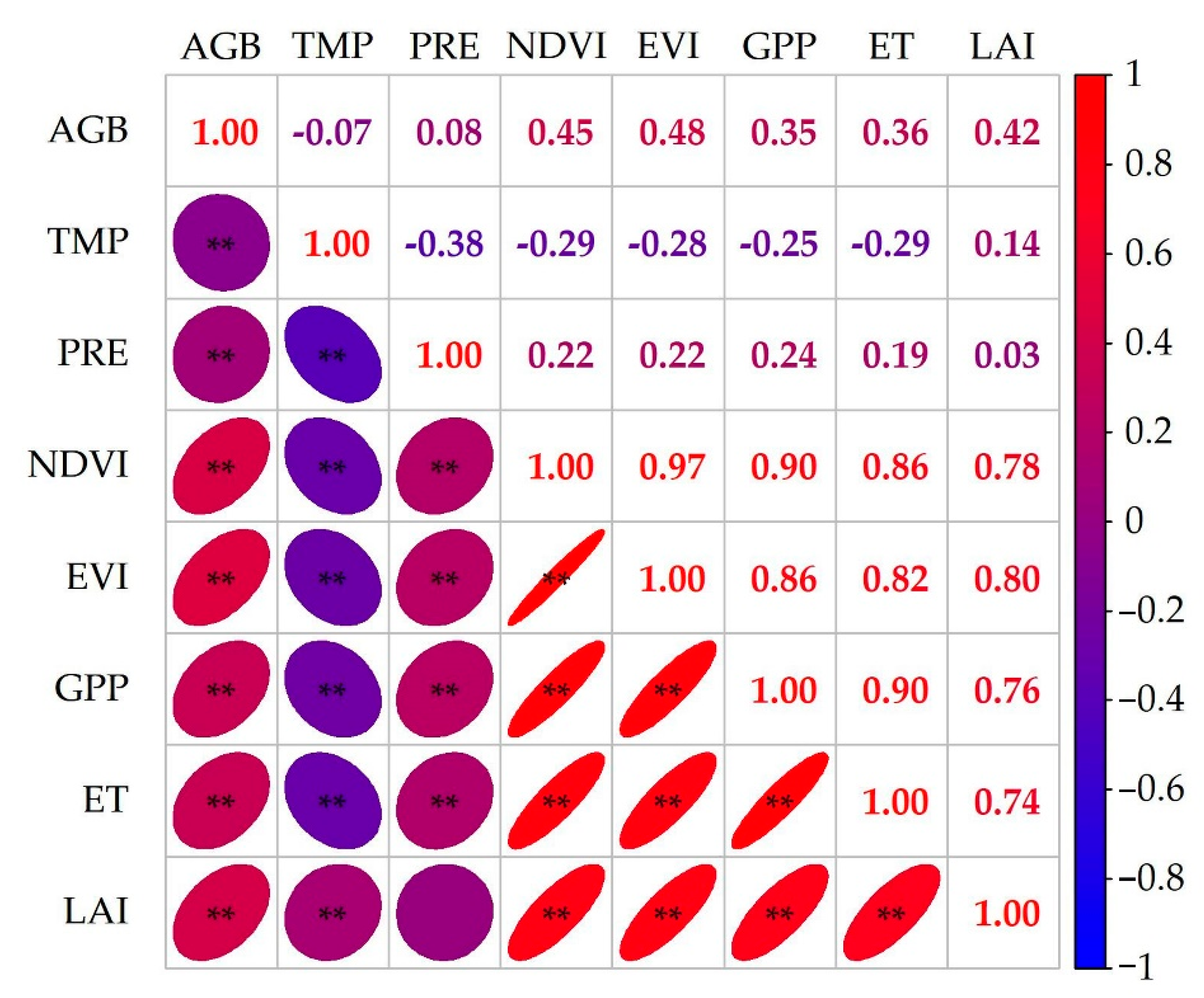
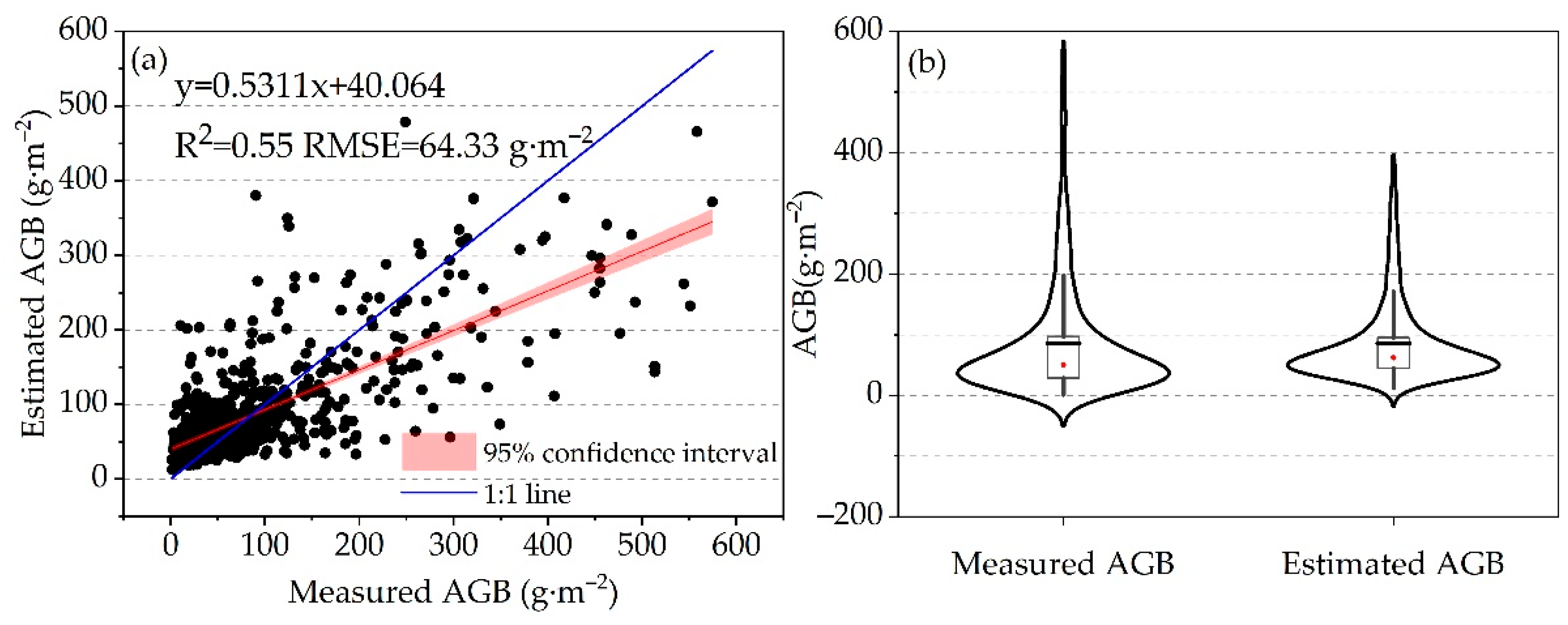
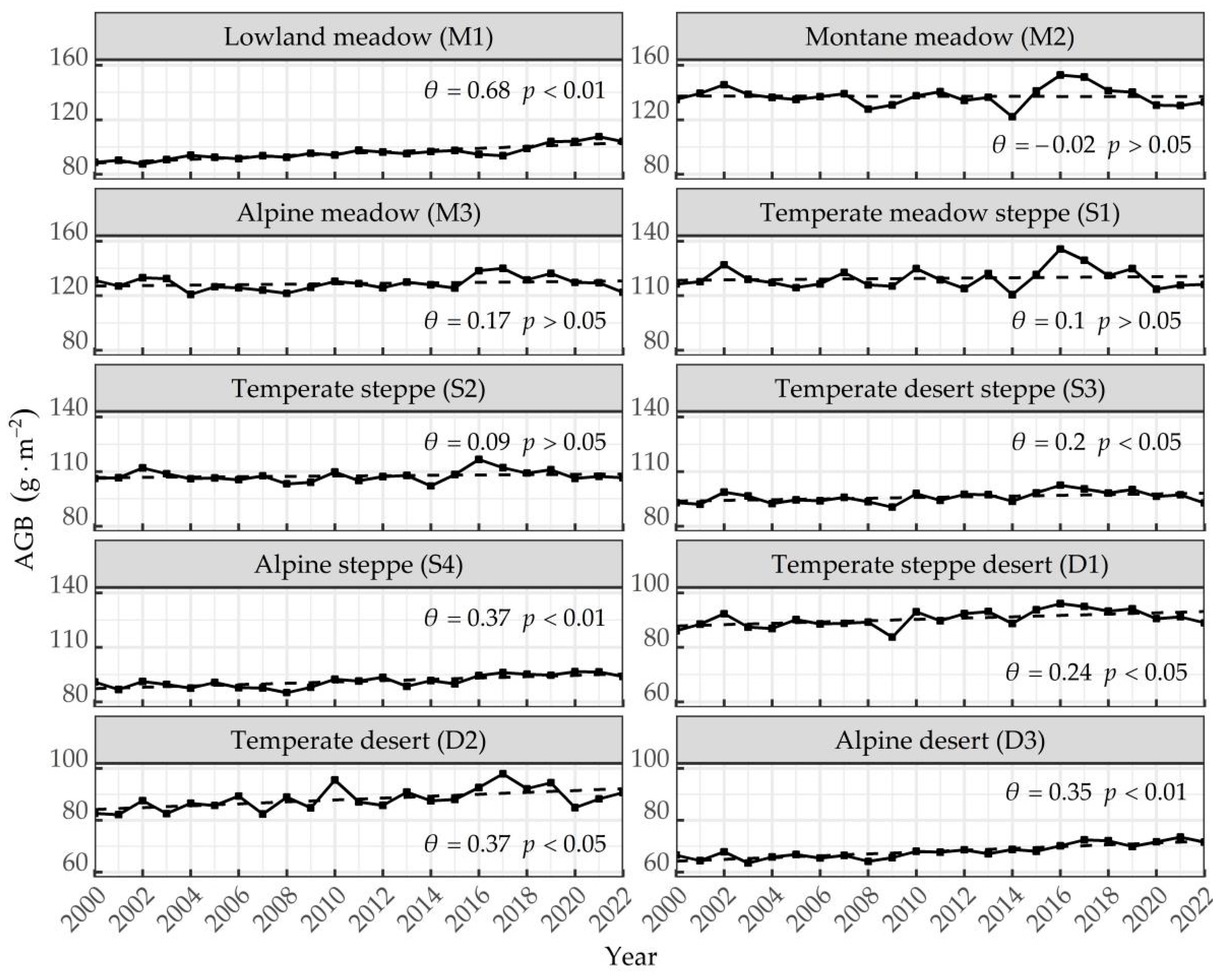


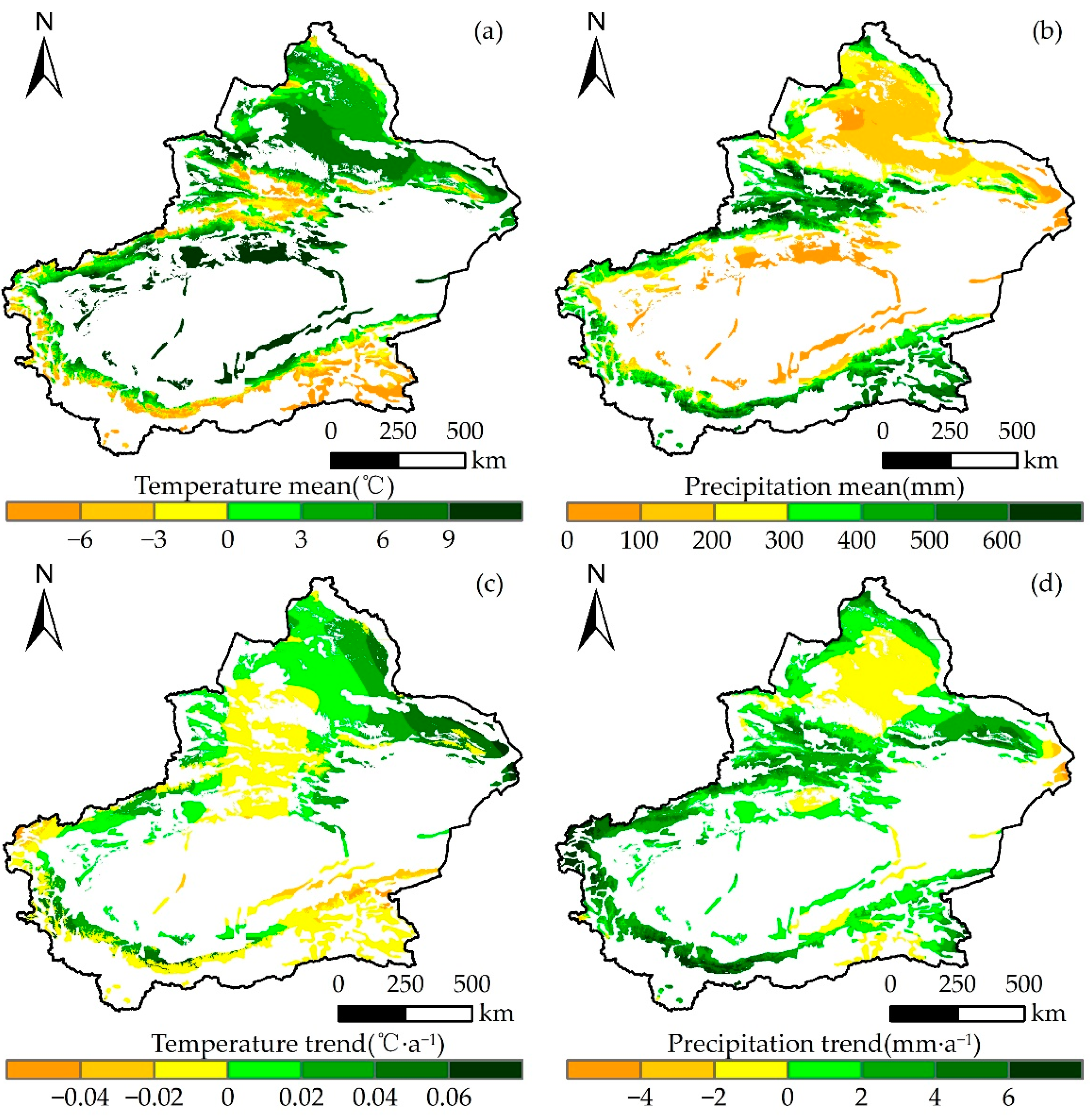
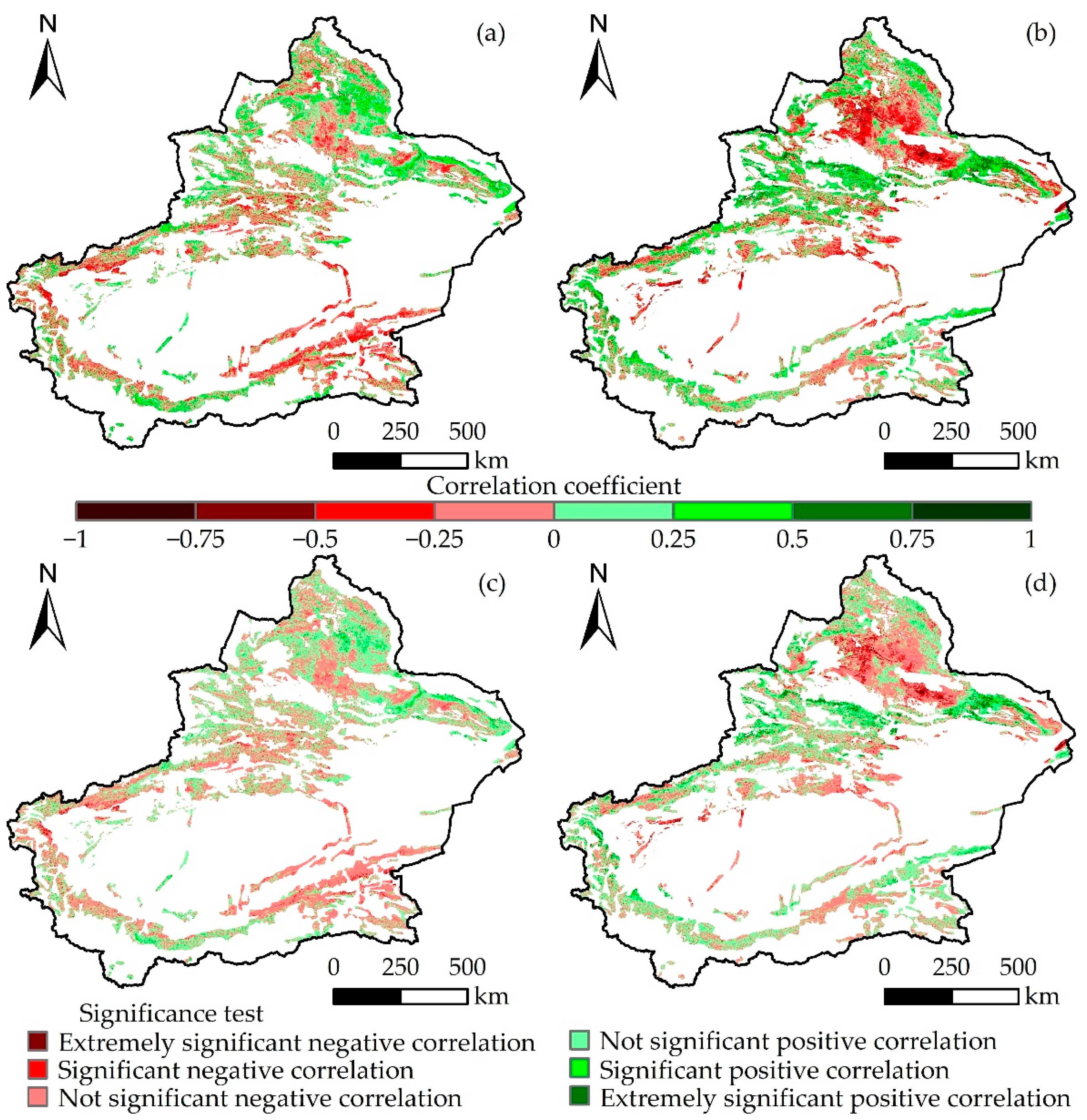
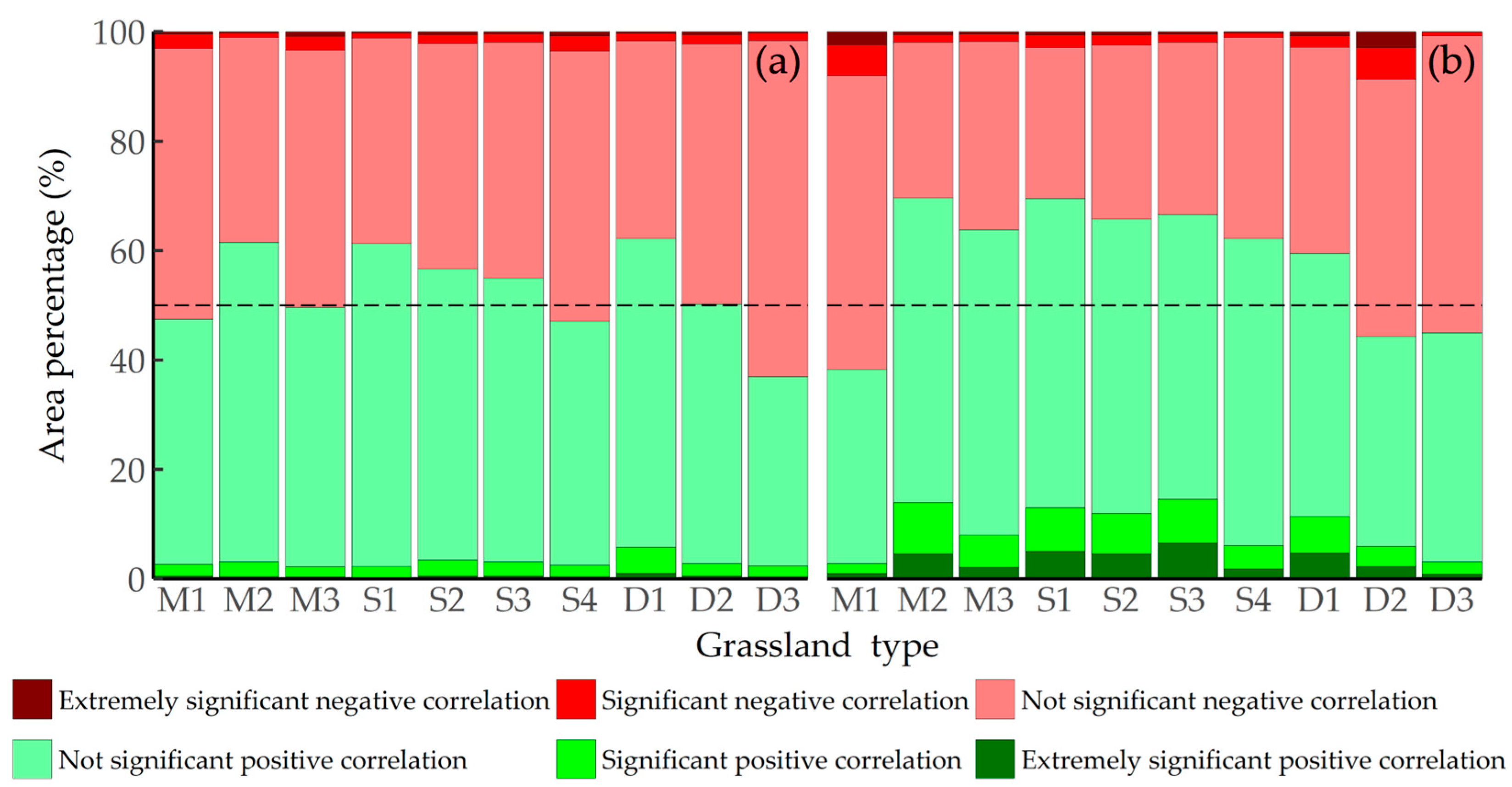


| Grassland Types | Mean Value (g·m−2) | Maximum Value (g·m−2) | Minimum Value (g·m−2) | Standard Deviation (g·m−2) | Coefficient Variable |
|---|---|---|---|---|---|
| Lowland meadow (M1) | 95.69 | 107.59 | 87.50 | 5.20 | 0.05 |
| Montane meadow (M2) | 137.21 | 152.77 | 122.18 | 6.94 | 0.05 |
| Alpine meadow (M3) | 128.91 | 140.02 | 120.89 | 4.98 | 0.04 |
| Meadow (M) | 120.60 | 152.77 | 87.50 | 18.95 | 0.16 |
| Temperate meadow steppe (S1) | 119.56 | 135.62 | 110.52 | 5.86 | 0.05 |
| Temperate steppe (S2) | 107.64 | 116.65 | 102.00 | 3.20 | 0.03 |
| Temperate desert steppe (S3) | 95.91 | 102.49 | 90.41 | 3.08 | 0.03 |
| Alpine steppe (S4) | 91.33 | 96.59 | 85.10 | 3.37 | 0.04 |
| Steppe (S) | 103.61 | 135.62 | 85.10 | 11.72 | 0.11 |
| Temperate steppe desert (D1) | 90.51 | 96.03 | 83.76 | 3.08 | 0.03 |
| Temperate desert (D2) | 88.19 | 97.90 | 82.17 | 4.32 | 0.05 |
| Alpine desert (D3) | 68.09 | 73.50 | 63.51 | 2.81 | 0.04 |
| Desert (D) | 82.27 | 97.90 | 63.51 | 10.70 | 0.13 |
| Grassland Types | Year of Mutation |
|---|---|
| Lowland meadow (M1) | 2009 |
| Montane meadow (M2) | 2004/2010/2014/2022 |
| Alpine meadow (M3) | 2014 |
| Temperate meadow steppe (S1) | 2005/2007/2010/2013 |
| Temperate steppe (S2) | 2003/2014 |
| Temperate desert steppe (S3) | 2009 |
| Alpine steppe (S4) | 2014 |
| Temperate steppe desert (D1) | 2009 |
| Temperate desert (D2) | 2006/2009 |
| Alpine desert (D3) | 2014 |
| Data | Year | Resolution | The Data Source |
|---|---|---|---|
| Grassland data | 1995 | / | http://www.geodata.cn/ (accessed on 10 March 2022) |
| Temperature | 2000–2022 | 1 km | http://www.resdc.cn (accessed on 5 April 2022) |
| Precipitation | 2000–2022 | 1 km | http://www.resdc.cn (accessed on 10 April 2022) |
| DEM | 1995 | 90 m | http://www.resdc.cn (accessed on 20 May 2022) |
| MODIS-NDVI | 2000–2022 | 500 m | https://ladsweb.modaps.eosdis.nasa.gov/ (accessed on 12 May 2023) |
| MODIS-EVI | 2000–2022 | 500 m | https://ladwedb.modaps.eosdis.nasa.gov/ (accessed on 19 May 2023) |
| MODIS-GPP | 2000–2022 | 500 m | https://ladwedb.modaps.eosdis.nasa.gov/ (accessed on 12 June 2023) |
| MODIS-LAI | 2000–2022 | 500 m | https://ladwedb.modaps.eosdis.nasa.gov/ (accessed on 8 July 2023) |
| MODIS-ET | 2000–2022 | 500 m | https://ladwedb.modaps.eosdis.nasa.gov/ (accessed on 20 July 2023) |
Disclaimer/Publisher’s Note: The statements, opinions and data contained in all publications are solely those of the individual author(s) and contributor(s) and not of MDPI and/or the editor(s). MDPI and/or the editor(s) disclaim responsibility for any injury to people or property resulting from any ideas, methods, instructions or products referred to in the content. |
© 2024 by the authors. Licensee MDPI, Basel, Switzerland. This article is an open access article distributed under the terms and conditions of the Creative Commons Attribution (CC BY) license (https://creativecommons.org/licenses/by/4.0/).
Share and Cite
Dong, P.; Jing, C.; Wang, G.; Shao, Y.; Gao, Y. The Estimation of Grassland Aboveground Biomass and Analysis of Its Response to Climatic Factors Using a Random Forest Algorithm in Xinjiang, China. Plants 2024, 13, 548. https://doi.org/10.3390/plants13040548
Dong P, Jing C, Wang G, Shao Y, Gao Y. The Estimation of Grassland Aboveground Biomass and Analysis of Its Response to Climatic Factors Using a Random Forest Algorithm in Xinjiang, China. Plants. 2024; 13(4):548. https://doi.org/10.3390/plants13040548
Chicago/Turabian StyleDong, Ping, Changqing Jing, Gongxin Wang, Yuqing Shao, and Yingzhi Gao. 2024. "The Estimation of Grassland Aboveground Biomass and Analysis of Its Response to Climatic Factors Using a Random Forest Algorithm in Xinjiang, China" Plants 13, no. 4: 548. https://doi.org/10.3390/plants13040548





